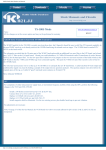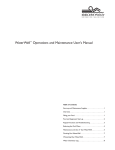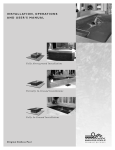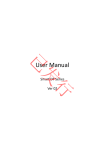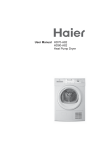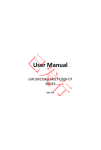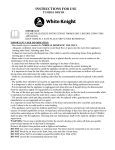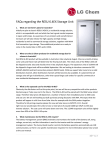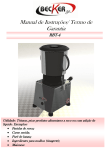Download Call us for your Jacuzzi
Transcript
Call us for your Jacuzzi® part needs! 1-888-JB-PARTS (527-2787) FREQUENTLY ASKED QUESTIONS IMPORTANT A primary objective in a swimming pool is to have clear, clean water. This is only achieved through a combination of good filtration and proper water chemistry. Your filtering system must operate long enough each day to effectively turn the total volume of your pool atleast once. This is normally achieved in an 8-10 hour period, however you should determine the time required for your specific pool based on the pool volume and the average flow rate of your pump. All of the pumps that Jacuzzi manufactures are designed for continuous duty, although it is not required for most pools. Proper water chemistry is critical to maintain clean, clear, sanitized water. You should consult with your pool dealer on the chemicals required and the schedule in which to dispense them. The guidelines for proper water balance require maintaining a free chlorine level in your pool of 1 to 3 ppm and a PH of 7.2 to 7.6. If these are not maintained, algae and bacteria will grow in your pool which will require your filter system to work overtime to clean the water .... if at all, depending upon the severity of the condition. PUMPS Your swimming pool pump is the heart of your filtering system. It is typically powered by either a 115 or 230 volt motor with single phase power. It spins a "wheel" inside the pump case (called an impeller) that develops the pressure that circulates the water. The pump is equipped with a strainer case which houses a basket that is used to capture debris that could clog the impeller. It is important to keep the strainer basket cleaned out so that the pump can get all the water it needs to perform properly. Why is there a continuous stream of tiny (air) bubbles in my pump strainer? • The strainer cover may be loose, cracked, or the o-ring seal may be damaged or missing. Inspect and replace if necessary. • Check the water level in the pool, it may be too low allowing air to reach the pump through the skimmer. The skimmer weir door may be stuck in the up position not allowing water to enter the skimmer. Also, check for toys blocking the skimmer opening. • Check for a suction leak, by turning the pump off and inspecting suction piping and fittings for leaks. Why is there one big air bubble in my Magnum Force strainer? My pump is running but I have no pressure at the pool, why? • This is a common misconception. You actually have a lot of pressure but very low water flow. This is usually caused by a dirty filter. You can verify this by reading the pressure on your filter pressure gauge. If the filter is clean, it will normally read 10-15 psi, when dirty it will read 20-25 psi. If it is dirty, clean or backwash the filter and the pressure should go down in the filter allowing full flow of water back to your pool. • Check for a partially closed valve in the return line or some other type of blockage in the return line. The impeller could also be clogged with debris. Visit us on the web.... http://www.jbparts.com 50 Have a parts list? Send us a fax. 585-533-1349 REV: 03.01.2002 • Don't worry about it! When first "priming" and starting a pump, the high velocity and turbulence of the water coming into the pump strainer normally captures any air in the pump strainer and carries it back to the pool. The combination of the "flap" and the 2" suction port on your Magnum Force minimize water velocity and turbulence, so the water coming into your pump basically "ignores" the air bubble that may have collected above the "flap" during "priming". This air bubble is not the result of a "suction leak". It has no effect on the performance of the pump. Your Magnum Force will give you 100% performance. Call us for your Jacuzzi® part needs! 1-888-JB-PARTS (527-2787) FREQUENTLY ASKED QUESTIONS How long do I need to run my pump to keep my pool clean? Can I run my pump all the time? • The length of time to run your pump will vary depending on such factors as daily usage, pool size, equipment size and weather. At minimum, the entire volume of water in your pool must be circulated through the filter once a day. To calculate how long this will take, you must determine the total gallonage in your pool and the average flow rate of your pump. Example: 27300 gallons = 420 minutes = 7 hours 65 GPM 60 min/hr • Running the pump 24 hours a day will not harm your pump, it is equipped with a continuous duty motor. My pump will not prime, Why? • Most swimming pool pumps are "self-priming". However, on initial startup you must fill the strainer case with water so the pump can prime. See your owners manual for proper priming procedures. • The pump may be located too high above the pool water level, requiring longer priming periods. Ideally, the pump should be at or just above the water level. •You may have a suction leak, see "Why is there a continuous stream of tiny air bubbles in my pump strainer?" Why does my pump run so hot? • Motors will run hot to the touch because the shell transfers some of the heat away from the motor windings. Make sure that there is plenty of air flow around the motor. Keep area around motor free of construction materials or other materials that could cause blockage of air flow to the motor. Also keep paint and other flammable materials away from the motor. • If you perceive that the motor heat is abnormal, you should contact a licensed electrician to check the voltage and amperage of the motor when it is in operation. High amperage will cause a motor to run hot. The causes of high amperage are: 1. Low Voltage - which is typically caused by power supply wire being undersized and/or wire is too long to get proper voltage to the motor. We do not recommend that you use an extension cord to power your pool pump. If you believe this may be the problem contact a licensed electrician to check your installation. 2. Motor is locked up - Something may be lodged in the pump impeller causing parts to bind and lock the motor up. 3. Motor bearings - The motor bearings may be beginning to wear. • If the motor is turning off and the pump has just been installed, check to be sure the proper voltage is supplied to the pump. Most pumps are dual voltage, meaning that they are capable of 115V or 230V. All pumps are wired 230V from the factory, so the pump may need to be changed to 115V, see wire diagram on motor. If you are not sure about how to switch the motor from 230V to 115V, contact a licensed electrician or your pool equipment installer. • The motor has a high limit switch that turns it "off" if the motor is overheating. The motor will automatically reset and turn "on" once it cools down. Repeated "tripping" and restarting of the pump motor can shorten the life of the motor. Overheating is typically caused by high amperage. High amperage is caused by: 1. Low voltage - which is typically caused by power supply wire being undersized and/or wire is too long to get proper voltage to the motor. We do not recommend that you use an extension cord to power your pool pump. If you believe that this may be the problem contact a licensed electrician to check your installation. 2. Motor is locked up - Something may be lodged in the pump impeller causing parts to bind and lock the motor up. 3. Motor bearings - The motor bearings may be beginning to wear. • The pump may be set up with an automatic timer that will control the run time so that you don't have to manually turn the pump on and off. Visit us on the web.... http://www.jbparts.com 51 Have a parts list? Send us a fax. 585-533-1349 REV: 03.01.2002 Why does my pump turn off by itself? Call us for your Jacuzzi® part needs! 1-888-JB-PARTS (527-2787) FREQUENTLY ASKED QUESTIONS Why is my pump so loud? • Pump noise is typically attributed to turbulence, vibration, or a mechanical noise. Turbulence - Is typically described as a gurgling sound which occurs if there is (cavitation) air mixing with water in the pump. Cavitation can be caused by a suction leak, a suction pipe being too small or if the suction line or skimmer basket are partially clogged. Vibration - Is the amplification of a pumps normal noise, which usually will decrease if the pump base is either firmly attached to the pump foundation or completely isolated by a rubberized or cushioned base. Mechanical noise - Is typically identified as a high pitched squealing sound. Common causes are worn motor bearings which are replaceable, and should be replaced by a qualified motor repair shop. Also inspect the impeller and diffuser, they may be rubbing. How much will it cost to operate my pump? • This depends on the length of time the pump is on each day. Typically a pool pump is required to run 8-12 hours. • To figure the cost, use the following formula: In this example, we used the electrical data for a 1HP pump. 8A x 230V = 1840 Watts (Amps and Volts can be found on the motor nameplate) 1840 Watts ÷ 1000 = 1.84kWh 1.84kWh x 8 Hrs. pump operates = 14.72 kWh 14.72kWh x .07 cost per kWh = $1.03 per day. Note: look on your last electric bill for cost per kWh. Is there a tool available to remove the Ring-Lok on my Magnum Force lid? • The Ring-Lok securing the clear lid on your Magnum Force pump strainer is designed to give you simple, tool-free access to your pump strainer basket. Even if the Ring-Lok is "really tight", there is a simple solution. When your pump is running, it creates suction in the pump strainer which pulls the clear lid down! So, while the pump is running, loosen the Ring-Lok + turn. Turn off the pump! The Ring-Lok should now come off with a simple twist. SAND FILTERS Sand Filters are the most commonly used filters for cleaning swimming pools, because of the ease of backwashing or cleaning the filter. They can filter out particles from 30 to 50 microns in size. The type of sand that is used is critical to the effectiveness of the filter. We recommend that the sand be pool grade #20 silica sand which is .45 to .55mm in size. As water is pumped into the filter at the top, it is pushed down through the sand bed. The sand particles trap the dirt and when the water reaches the bottom manifold of the filter, it is clean and returned to the pool. • High pressure typically means that the filter sand is dirty and needs backwashing. Follow the instructions for backwashing "How do I backwash my filter?" or refer to your owners manual or follow the instructions noted on the label located on the tank body. • Check to ensure that no valves are closed in the return line to the pool and that there is no blockage in the return line. • Over time, the sand in your filter can become calcified or hardened from chemical buildup. If this has occurred, you can add a degreaser to try and loosen the sand. Often if this has occurred, the sand will need to be replaced. Visit us on the web.... http://www.jbparts.com 52 Have a parts list? Send us a fax. 585-533-1349 REV: 03.01.2002 Why is the pressure in my sand filter so high? Call us for your Jacuzzi® part needs! 1-888-JB-PARTS (527-2787) FREQUENTLY ASKED QUESTIONS Do I have to backwash daily? How do I know when to backwash? • No, you do not have to backwash daily. Excessive backwashing is not recommended. Over time, the effectiveness of the sand bed to remove particles improves. • Backwash the filter when the pressure increases 10 psi above the pressure when it is clean. Typically, a clean filter will run 10-15 psi, so backwash when the pressure is 20-25 psi. How do I backwash my filter? • Turn the pump off. • Turn the filter valve handle to Backwash. • Turn the pump on. • Typically it will take 2-3 minutes to backwash the debris from your filter. If your filter has a backwash sight glass, backwash until the water is clear. • Turn the pump off. • Turn the filter valve handle to Rinse. (Note: this setting is not available on all valves. If you do not have a rinse position on your valve, set the handle to Filter and restart the pump.) • Turn the pump on and rinse for 20-30 seconds. This action removes any debris trapped in the filter during backwash. • Turn the pump off. • Turn the filter valve to Filter and restart the pump. Why is sand going into the pool? • The most common cause is a cracked lateral in the underdrain system. You must remove the sand from the filter and inspect the lateral / underdrain system and replace any cracked or damaged parts. • The sand you are using may be too small, allowing it to pass through the underdrain system. The proper grade sand is #20 silica which is .45 to .55 mm in size. Consult with your local pool dealer. Why won't my filter keep my pool clean? • You may not be running the pool long enough. Typically you should run the pump 8-12 hrs a day or until you turn the entire volume of your pool once a day. • Check your chemical balance. Out of balance water can cause cloudiness. • Make sure you have the proper amount of sand in your filter. Remove the dial valve and inspect the level of sand, if you have a Laser series filter the sand should be 1"-2" below the bottom of the basket. Also make sure the upper standpipe and lower standpipe are connected tightly into the basket. • How old is the sand? The sand should be replaced every 5 years to ensure proper filtration. • Pool Filters can not filter out live algae. The algae must be killed by super chlorinating your pool water. Once this is done the dead algae can be removed with the assistance of the flocking agent. Consult your local pool dealer on chemical recommendations. I have noticed sand is coming out of my backwash line during backwash, is this normal? • No, you should not lose sand during backwash. • This usually indicates that the backwash flow rate is too high and needs to be reduced. This can be done by putting a valve on the backwash line or installing a restrictive adapter in the backwash port. Visit us on the web.... http://www.jbparts.com 53 Have a parts list? Send us a fax. 585-533-1349 REV: 03.01.2002 I have algae in my pool and my filter isn't clearing it up. Why? Call us for your Jacuzzi® part needs! 1-888-JB-PARTS (527-2787) FREQUENTLY ASKED QUESTIONS When the dial valve is set on filter, water is leaking out the backwash line. Why? • A small amount of debris or sand may be trapped between the diverter gasket and the valve plate. To clean the valve, push down on the valve handle while the pump is running. This will flush out the valve and usually resolve the problem. Note that when you push down on the valve handle, water will pour out of the backwash port. • If flushing the valve out does not resolve the problem, then you will need to remove the valve cover and visually inspect the diverter gasket for debris or damage. Clean valve body and diverter gasket with water or replace diverter assembly if necessary. How often does the sand need to be changed? • As preventative maintenance, we recommend replacing the sand every five years. How do I change the sand in my filter? • Set the dial valve handle to the test position. Remove the dial valve at the tank flange (the valve will be attached by hex head bolts or a stainless steel clamp). Remove the upper diverter and basket assembly if you have a Laser, MFM or SandTrap series filter. • The easiest way to remove the sand is by using a wet/dry shop vac. (Note: Place a plastic trash bag in the shop vac canister for easy disposal.) If you do not have access to a shop vac, then you must scoop the sand out of the tank. We do not recommend laying the tank on its side, as this could also damage the underdrain system. • Once the sand is removed, fill the tank half way with water. Cover the standpipe opening. (Also cover the tank flange bolt holes, if applicable) • Slowly pour the appropriate amount of sand into the tank. • Remove the cover over the standpipe. Replace the diverter and basket assembly if applicable. • Install the dial valve. I have very little flow back to the pool, the filter pressure is low and water is coming out of the backwash line? • The hoses are connected to the filter valve incorrectly. The three connections on the valve are labled: PUMP, RETURN, WASTE. Make sure the hose from the pump is connected to the port marked PUMP and that the hose to the pool is connected to the port marked RETURN. Air is accumulating in my filter tank and when I turn my pump off, I notice air rushing back into the pump and into the pool through the skimmer. There are several positions on the filter valve. What does each position do? • Filter - Water is distributed onto the sand bed. The water flows downward through the sand bed as dirt and debris are captured by the sand. The clean water enters into the distribution system at the bottom of the tank. This clean water is pushed up the center standpipe and returned back to the pool. • Backwash - Water is directed into the center standpipe and enters the distribution system at the bottom of the tank. The water flows upward through the sand bed washing the dirt and debris up and out of the filter through the waste line. Visit us on the web.... http://www.jbparts.com 54 Have a parts list? Send us a fax. 585-533-1349 REV: 03.01.2002 • The underneath side of the dial valve has a small diameter hole drilled in it, which allows air to return to the pool through the return fitting. This hole has become clogged and you will need to remove the valve and unplug this air relief hole by inserting a wire (straightened paper clip) or anything available that will fit in the hole. This hole is drilled in the ramped section on the underneath side of the valve. Call us for your Jacuzzi® part needs! 1-888-JB-PARTS (527-2787) FREQUENTLY ASKED QUESTIONS • Rinse - Water is distributed onto the sand bed. The water flows downward through the sand bed to settle it after backwashing. The water enters the distribution system at the bottom of the tank and is pushed up the center standpipe and discharged out the waste line. (Note: This position is not found on all valves and is only used after backwashing.) • Whirlpool - Water flows directly through the valve and is returned back to the pool. This position is used if you do not want to circulate water into the sand bed. • Drain - Water flows directly through the valve and out the waste line. This position can also be used to vacuum heavy amounts of debris to waste. • Test - Water will not flow in or out of the valve. If pool equipment is below the water level, use this position when cleaning the hair and lint strainer on the pump. It will prevent water from flowing from the pool through the return line. • Winterize - This position lifts the diverter up from the valve plate to keep the diverter gasket from flattening out during offseason. It also allows air to enter the tank when draining. CARTRIDGE ELEMENT FILTERS Cartridge Element Filters represent approximately 25% of the pool filters sold in the U.S. and are gaining in popularity due to water conservation issues. They are capable of filtering out particles from 10 to 15 microns in size. Cartridge elements are made of a strong, polyester fabric. As water passes through the cartridge element, dirt is captured on the surface of the element. The cartridge element can be removed and cleaned by spraying it off with a garden hose. When I vacuum my pool, I see debris going back to the pool. Why? • Water may be bypassing the element through a hole or tear in the element. Inspect the element and replace if necessary. • The element may not be positioned properly on the dirt catcher. Make sure the element is positioned so that THIS SIDE UP is showing and that the element is sealed at the top of the dirt catcher. • The element may have collapsed causing debris to bypass at the top of the element where it seals to the dirt catcher. Visually you will be able to see if this has occurred because the pleats on the element will not be vertical towards the top of the element. This typically occurs if the pressure has been high (25-35 psi) for extended periods. If the element has collapsed, it will need to be replaced. • The dirt catcher could be cracked, inspect and replace if necessary. How long will my element last, should I replace it every year? • The element is designed to last a couple of seasons if it is properly maintained. • The signs of a worn out element are: support bands are loose or missing, cartridge material is torn or ripped, pleates have deflected and are not vertical at top of element or filter pressure remains high even after thorough cleaning. • Routine maintenance is the key to extending the life of an element. • The bands are carefully adhered to the outer edge of the pleat knuckle and will not come loose or break in normal use. However, acid soaking, rough handling or the use of a high pressure car wash sprayer can cause the bands to break and in some instances even separate from the element. • Loose or missing bands often indicates a worn out element and indicates that it's time to replace the element. • A split band, even if broken in several places will not effect the filtration performance of the element. Visit us on the web.... http://www.jbparts.com 55 Have a parts list? Send us a fax. 585-533-1349 REV: 03.01.2002 What if the support bands break or come off the element? Call us for your Jacuzzi® part needs! 1-888-JB-PARTS (527-2787) FREQUENTLY ASKED QUESTIONS How often should I clean my element? • Clean the filter element when the pressure increases 10 psi above the pressure when it was clean. Typically, a clean filter will run 10-15 psi, so clean the element when the pressure is 20-25 psi. What is the best way to clean the element? • Spray the element from the inside/out to force debris out of the pleats, or spray water at an angle to the pleats to wash debris away. We do not recommend that you use a high pressure car wash sprayer, as this can break the pleat bands or tear the cloth. • Once you have cleaned the element by rinsing it off, reinstall it into the filter canister. If the pressure does not decrease to your "clean" reading (10-15 psi) you may have a buildup of suntan lotions or body oils that are restricting the flow. If this occurs we recommend soaking the element overnight in 1 cup of automatic dishwashing detergent to 5 gallons of water. If algae are present, add one pint of liquid chlorine or one quart of liquid household bleach one hour before removing the cartridge element from the cleaning solution. Remove and thoroughly rinse the element before putting it back into the filter housing. After I clean the cartridge element and replace the lid and Ring-Lok, I notice water leaking at the Ring-Lok. Why? • You should clean and lubricate (okay to use Vaseline) the o-ring before you replace the lid, this assures that you get a good, tight seal. The o-ring could also be pinched or damaged. Inspect the o-ring and replace if necessary. • Acid washing is one of the biggest single factors leading to premature element failure. For years, service technicians and homeowners have acid washed D.E. grids. So, it seems natural to do the same thing to cartridge filter elements. There is however, a difference. Grids are coated by application with D.E. powder. The D.E. absorbs oils and other organics before they reach the grid cloth. Cartridge elements have no such protective coating. The polyester fiber used in the filter media of elements actually attracts and holds oils, body fluids and other organic matter. If acid is applied to the filter element in the presence of these organics, you may permanently plug the element. Acid causes the fiber's surface to become tacky. Since acid does not remove organic matter, the tacky surface acts like glue permanently bonding the organic material to the media. The resulting plugged media can not be restored to its original condition, causing short cycle runs and high differential pressure. • Here is a simple test to determine if acid washing is required. After thoroughly cleaning the element with a soapy water solution or degreasing agent, flush the element with a garden hose to remove all traces of soap, etc. Now apply several drops of acid directly to a small area of the filter element. If no bubbling is obseved your element does not require acid washing. If bubbling occurs, indicating a build up of calcium or minerals, soak the element in a solution of one part muriatic acid to twenty parts water. Leave the element in this solution until the bubbling stops. Remove and thoroughly rinse the element before putting it back in the filter. • As a rule of thumb, acid wash only when required, if at all, and never without thoroughly cleaning the element with a soapy water solution or degreaser first. • WARNING: Wear rubber gloves and safety glasses when using acid or chlorine. Do not mix chlorine or liquid bleach with acid. Always add acid to water. • Please Note: If you are using Bacquacil or Soft Swim products, your cleaning procedure will be different, contact your local dealer for proper cleaning procedures. Visit us on the web.... http://www.jbparts.com 56 Have a parts list? Send us a fax. 585-533-1349 REV: 03.01.2002 Should I acid clean my filter element? Call us for your Jacuzzi® part needs! 1-888-JB-PARTS (527-2787) FREQUENTLY ASKED QUESTIONS DIATOMACEOUS EARTH (D.E.) FILTERS DE Filters represent approximately 25% of the pool filters sold in the U.S. They are capable of filtering out particles from 2-5 microns in size. This ability to filter out such fine particles is the reason that D.E. filters are so popular. D.E. is a porous powder that comes from fossil-like, prehistoric water plants called diatoms. Like snowflakes, diatoms are extremely porous and unique in shape. When billions of these diatoms form a thin coating on the filter grids, they create one of nature's most incredible natural screens and provide sparkling, clear water. When the pressure in the filter increases, the D.E. can be regenerated to try and extend the filter cycle or the D.E. is backwashed out of the filter and new D.E. is added to the system. Periodically the filter grids must be removed from the filter and thoroughly cleaned. Why is the pressure in my filter so high? How often do I need to change the D.E. in my filter? • High pressure typically indicates that the D.E. in the filter is dirty. Typically, a clean filter will run at 10-15 psi and a 10 psi rise to 20-25 indicates that the D.E. is dirty. To reduce the pressure and extend your filter cycle you can regenerate the D.E. (Refer to - "How can I extend my filter cycle by regenerating the D.E."). If the pressure increases to 20-25 psi within 72 hours then you should remove the grids, clean them and recharge the filter with D.E. • Check to insure that no valves are closed in the return line to the pool and that there is no blockage in the return line. How can I extend my filter cycle by regenerating the D.E.? • If you have a Landslide or Avalanche series filter - Turn the pump off, loosen the yellow air bleed knob and move the Thandle slowly up and down three times or until there is free movement. Push the handle back to the down position and tighten air bleed knob. Restart the pump and you should notice a reduction in the filter pressure. If the pressure does not decrease or it decreases for only a short period of time then this is an indication that the D.E. needs to be changed. • If you have an EarthWorks series filter - While the pump is running, move the brass handle at the bottom of the filter back and forth several times. Make sure you return the handle to the filter position when completed. You should notice a reduction in the filter pressure. If the pressure does not decrease or it decreases for only a short period of time then this is an indication that the D.E. needs to be changed. Can I backwash the D.E. from my filter? • If you have an EarthWorks series filter you can backwash the D.E. from the filter by opening the waste port on the filter and setting the valve handle to the Backwash position. Turn the pump on and backwash for 2-3 minutes or until the water is clear coming out of the waste line. • Landslide and Avalanche series filters do not have a backwash valve and therefore can not be backwashed. To remove the D.E. from the filter we recommend removing the grids and cleaning them. • If your filter has a backwash valve, backwash the D.E. from the filter. If this does not have a backwash valve proceed to the next step. • Turn the pump off and remove the Ring-Lok and lid. Remove the grid cassette and wash the D.E. from the grids using a garden hose spray nozzle. You may want to remove the grids from the assembly to assure that all of the D.E. is being removed. • Typically hosing the grids off is sufficient, however twice a season we recommend soaking the grids overnight in 1 cup of automatic dishwashing detergent to 5 gallons of water. This will remove suntan lotion and other organic residue that builds up over time and can cause problems if not controlled. Before reinstalling the grids, lightly scrub the grids with a soft brush, rinsing them thoroughly with water. Visit us on the web.... http://www.jbparts.com 57 Have a parts list? Send us a fax. 585-533-1349 REV: 03.01.2002 What is the proper way of cleaning the grids in my filter? Call us for your Jacuzzi® part needs! 1-888-JB-PARTS (527-2787) FREQUENTLY ASKED QUESTIONS How do I change the D.E. in my filter? • Once you have cleaned the grids and removed all the D.E. from the filter. Reinstall the grid cassette in the filter and install the lid and Ring-Lok, keeping the air relief valve open. Place an appropriate quantity of D.E. in a bucket, then add water. Be sure that this D.E. mixture is thin enough so that it can be poured into the skimmer. Turn the pump on and pour the D.E. mixture into the pool skimmer closest to the pump. Close the air bleed valve when a steady flow of water emerges. This will distribute the mixture of D.E. evenly on the grids. NOTE: If you run the pump for an extended period of time before pouring in the D.E. mixture, there is a chance that the grids will be contaminated by debris from the pool. Why is my filter throwing D.E. or debris back to the pool? • Inspect the grids to ensure that they are inserted correctly in the manifold. For Landslide or Avalanche series filters make sure that the straps are properly tightened, so that the grids are secure in the manifold. For Earthworks series filters make sure the rubber retainer ring is in place in the groove in the standpipe, this holds the grid cassette together. • Inspect the grids for holes or tearing, replace if necessary. • Inspect the manifold for cracks, replace if necessary. After I clean the grids and reassemble the filter, I notice water leaking at the Ring-Lok? • You should clean and lubricate the o-ring before you replace the lid (okay to use Vaseline), this assures that you get a good, tight seal. The o-ring may also be pinched or damaged. Inspect the o-ring and replace if necessary. • The lid sealing surface should also be cleaned each time the filter lid is removed. This assures that the o-ring has a clean surface to seal against. Should I acid clean my filter grids? • Here is a simple test to determine if acid washing is required. After thoroughly cleaning the grids in a soapy water solution (Refer to - "What is the proper way of cleaning the grids in my filter"), rinse the grids with a garden hose to remove all traces of soap. Apply several drops of acid directly to a small area of the filter media. If no bubbling is obseved the grids most likely do not require acid washing. If bubbling occurs, this is an indication that a build up of calcium or minerals is present and a mild acid soak is necessary. Soak the grids in a separate solution of one part muriatic acid to twenty parts water, leave the grids in this solution until the bubbling stops. Thoroughly rinse the grids before installing them back into your filter. • IMPORTANT - Acid wash only when required, if at all, and never without thoroughly cleaning the element with a soapy water solution or with a degreaser first. • WARNING: Wear rubber gloves and safety glasses when using acid or chlorine. Do not mix chlorine or liquid bleach with acid. Always add acid to water. • Please Note: If you are using Bacquacil or Soft Swim products, your cleaning procedure will be different, contact your local dealer for proper cleaning instructions. • Dirt or D.E. has worked it's way under the valve and is creating a path for water to bypass to the waste line. Remove the grid cassette from the filter and loosen the dial valve thumb screw located at the bottom of the filter. Remove the valve spring and handle. Then remove the valve from the inside tank. Inspect the gasket, on the underneath side of the valve for debris. Clean the gasket and the tank valve sealing the surface and reinstall the valve. If the gasket is damaged, the valve will have to be replaced. Visit us on the web.... http://www.jbparts.com 58 Have a parts list? Send us a fax. 585-533-1349 REV: 03.01.2002 Why is water leaking out of the waste line when the valve on my EarthWorks filter is set to filter?









